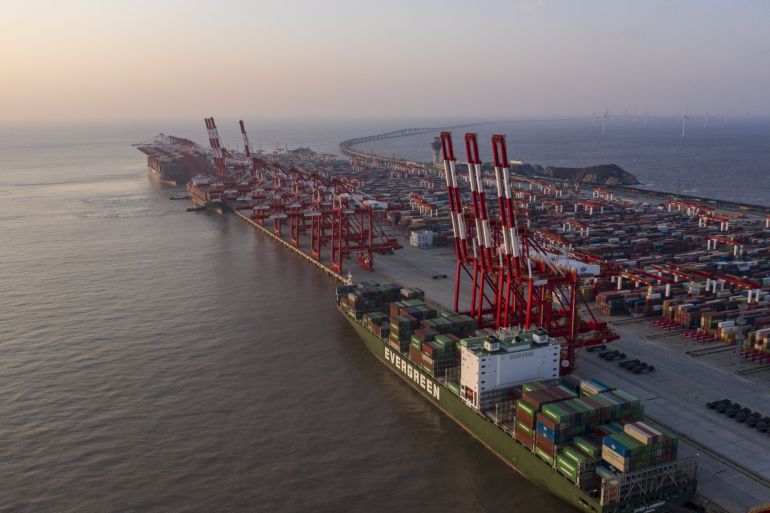As Shanghai lockdown drags on, fears grow for global trade
China’s strict pandemic policies have shuttered factories and prevented ships from unloading and picking up cargo.

Bengaluru, India – At a chemist in the upmarket neighbourhood of Koramangala in Bengaluru, India, owner Ram Narain anxiously asked one of his workers to check stocks of a long list of medicines scribbled on a sheet of paper.
As the employee yelled back numbers, Narain shook his head. Asked what was worrying him, he sighed.
Keep reading
list of 4 itemsBiden says Russia committing ‘genocide’ in Ukraine
Biden boosts ethanol to lower US fuel prices amid war in Ukraine
Egypt prosecution says no criminal suspicion in economist’s death
“The same thing that’s troubling everyone else — the new lockdown in China.”
India is a major drug producer but sources 70 percent of its active pharmaceutical ingredients — the biologically active component of any medicine — from China. The indefinite COVID-19 lockdown since late March in Shanghai, home to the world’s largest container port, is threatening those supplies.
Narain’s concerns reflect growing worries that the restrictions imposed by authorities in the city of 25 million people could disrupt international supply chains of everything from medicines to electric vehicles, stalling the global economic recovery even as nations are finally opening up fully after two years.
So far, China’s economy has borne the brunt of the record surge in coronavirus cases in the country’s economic nerve centre. But analysts are warning that Shanghai’s unmatched role in global trade means that the lockdown could have severe implications for the rest of the world, especially if it lasts much longer. Shanghai and the regions near it are among China’s biggest manufacturing hubs. They rely on imported components that enter the country through the city’s port, which is also how finished goods are then exported.
The effect of that three-pronged dependence on the city is starting to show. Tesla shut down its Giga factory in Shanghai on March 28 and is yet to reopen the facility that produces about 2,000 electric cars a day. Its Chinese rival Nio suspended production on Saturday, citing the increase in cases in Shanghai and the provinces of Jiangsu and Jilin, where it has plants.

The Shanghai Containerized Freight Index, already in decline because of the war in Ukraine, is continuing to slide, signalling a drop in Shanghai’s exports, said Bruce Pang, the head of macro and strategy research at Hong Kong-based China Renaissance Securities.
“China’s worst COVID outbreak may lead to delays and higher prices, which could stall recovery and further add to global inflation,” Pang told Al Jazeera.
Until now, the effect of the lockdown in Shanghai on global supply chains has been limited, said Julian Evans-Pritchard, senior China economist at Capital Economics, a London-headquartered consultancy. Many factories are continuing to operate using what is known as a closed-loop system — where workers stay in their workplace through the lockdown to reduce the risk of catching an infection.
“Most of the factory floor workers are migrants with limited safety nets, who will put up with it to keep their jobs,” Evans-Pritchard told Al Jazeera. “A large number already live in employer-provided dormitories even in normal times.”
Chinese manufacturers also have healthy inventories that they can count on to ride out short lockdowns, he added. But Pang and many other analysts believe that the current restrictions in Shanghai will last until at least June.
“If the closures drag on for too long then it would lead to product shortages both in and outside of China,” Pritchard-Evans said.
Ominous signs are already emerging. An April 7 report by Hong Kong-based experts of Spanish financial services firm BBVA shows that vehicle freight traffic at Shanghai port has plunged during the lockdown, while the congestion of vessels waiting outside the port is growing. The BBVA researchers also estimate that there is a real possibility — they have assigned it a 25 percent likelihood — that Shanghai fails to stamp out the current wave by June.
China can mitigate the fallout of the Shanghai lockdown on global trade by turning to its other ports, said Wang Huiyao, founder and president of the Center for China and Globalization, a Beijing-based think tank.
“You have to remember — China has other massive ports that can still serve the world,” Wang told Al Jazeera. Indeed, seven of the world’s 10 biggest container ports are in China: Shanghai, Ningbo-Zhoushan, Shenzhen, Guangzhou, Qingdao, Hong Kong and Tianjin.
Most of these cities have had lockdowns of different durations in the past few months. Yet China witnessed a sharp increase in exports in 2021, even amid a global semiconductor shortage.
“The options China has, in terms of gateways to the world, have enabled this,” Wang said.
Emerging economies at risk
Still, Shanghai carries an outsized burden as a container port: it alone handled 20 percent of China’s freight traffic in 2021.
“If Shanghai port stops functioning, it’s difficult for other nearby ports to fill in the void given its gigantic capacity,” BBVA researchers Betty Huang and Xia Le wrote in their report. “By then the global supply chain will directly feel the pain of Shanghai’s lockdown.”
Emerging Asian economies such as Vietnam and Cambodia could take the biggest hit because of their dependence on Chinese inputs for manufacturing, Capital Economics has warned in recent reports. Chinese components contribute 24 percent of the gross value added to Vietnam’s manufacturing sector.
But others will not be immune: Goods imported directly or indirectly from China constitute more than 20 percent of Japan’s total imports, and in excess of 15 percent of the United State’s purchases from abroad.
At a time when the pandemic has already made many nations and companies queasy about depending too much on Chinese supply chains, Shanghai’s lockdown is also reviving questions about the economic logic of the country’s “zero-COVID” strategy. Under the zero-tolerance approach, China places entire cities in lockdown when new cases emerge, despite the vast majority of the world moving away from strict controls and learning to live with the virus.
“The pandemic has highlighted the need for greater supply chain diversification and resilience,” Pritchard-Evans said. “The latest developments in China are just another reminder of that.”
While Beijing has promised to continue its elimination efforts, there are signs that authorities are increasingly concerned about the economic and social toll of draconian lockdowns. On Monday, authorities in Shanghai announced a slight easing of restrictions to allow greater freedom of movement for residents in areas where the virus is under control.
Under the three-tier disease control system, residents in areas where no cases have been reported for 14 days are permitted to leave their homes provided they follow health protocols and remain in their sub-district. Residents in areas that have gone seven days without a case are allowed to collect food deliveries or go for a walk at a designated time and location.
Wang said the crisis in Shanghai might also offer China’s leaders a chance to compare the mainland’s strategy with that of Hong Kong, which avoided a city-wide lockdown even at the peak of a devastating COVID-19 wave earlier this year when it had the world’s highest death rate from the virus.
“It’s a tale of two cities,” the Beijing-based analyst said. “And the approach that works better will shape China’s policy for the future.”